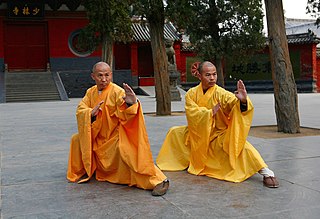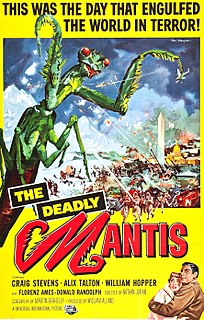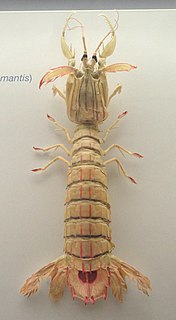
Mantis shrimps, or stomatopods, are carnivorous marine crustaceans of the order Stomatopoda, branching from other members of the class Malacostraca around 340 million years ago. Mantis shrimps typically grow to around 10 cm (3.9 in) in length, while a few can reach up to 38 cm (15 in). The largest mantis shrimp ever caught had a length of 46 cm (18 in); it was caught in the Indian River near Fort Pierce, Florida, in the United States. A mantis shrimp's carapace covers only the rear part of the head and the first four segments of the thorax. Varieties range in color from shades of brown to vivid colors, with more than 450 species of mantis shrimps being known. They are among the most important predators in many shallow, tropical and subtropical marine habitats. However, despite being common, they are poorly understood, as many species spend most of their lives tucked away in burrows and holes.

Northern Praying Mantis is a style of Chinese martial arts, sometimes called Shandong Praying Mantis after its province of origin. It was created by Wang Lang (王朗) and was named after the praying mantis, an insect, the aggressiveness of which inspired the style. One Mantis legend places the creation of the style in the Song Dynasty when Wang Lang was supposedly one of 18 masters gathered by the Abbot Fu Ju (福居), a legendary persona of the historical Abbot Fu Yu (福裕) (1203–1275), to improve Shaolin martial arts. However, most legends place Wang Lang in the late Ming Dynasty.

Mantidae is one of the largest families in the order of praying mantises, based on the type species Mantis religiosa; however, most genera are tropical or subtropical. Historically, this was the only family in the order, and many references still use the term "mantid" to refer to any mantis. Technically, however, "mantid" refers only to members of the family Mantidae, and not the 14 remaining families of mantises. Some of the most recent classifications have promoted a number of the mantid subfamilies to the rank of family, e.g. Iridopterygidae, Sibyllidae, Tarachodidae, Thespidae, and Toxoderidae, while other classifications have reduced the number of subfamilies without elevating to higher rank.

An ootheca is a type of egg mass made by any member of a variety of species including mollusks, mantises, and cockroaches.

The Deadly Mantis is a 1957 American science-fiction monster film produced by William Alland for Universal-International. The film was directed by Nathan Juran from a screenplay by Martin Berkeley based on a story by producer William Alland. The Deadly Mantis stars Craig Stevens, William Hopper, Alix Talton and Pat Conway.

Mantis Bug Tracker is a free and open source, web-based bug tracking system. The most common use of MantisBT is to track software defects. However, MantisBT is often configured by users to serve as a more generic issue tracking system and project management tool.

Rougarou, formerly known as Mantis, is a floorless roller coaster located at Cedar Point amusement park in Sandusky, Ohio. Designed and built by Bolliger & Mabillard, the roller coaster originally opened in 1996 as a stand-up roller coaster called Mantis, which at the time was the tallest, fastest, and longest of its kind in the world. Cedar Point had planned to name the ride Banshee, but due to negative publicity following the announcement, the name was later changed to Mantis.

Mantis is a fictional character that appears in comic books published by DC Comics, part of Jack Kirby's New Gods series.

Mantis is a fictional character appearing in American comic books published by Marvel Comics. The character has been a member of the Avengers and the Guardians of the Galaxy.

The term insectoid denotes any creature or object that shares a similar body or traits with common earth insects and arachnids. The term is a combination of "insect" and "-oid".

Khomeyn County is a county in Markazi Province in Iran. The capital of the county is Khomeyn. At the 2006 census, the county's population was 108,840, in 29,888 families. The county is subdivided into two districts: the Central District and Kamareh District. The county has two cities: Khomeyn and Qurchi Bashi.

Flower mantises are those species of praying mantises that mimic flowers. Their coloration is an example of aggressive mimicry, a form of camouflage in which a predator's colours and patterns lure prey. The flower mantises are not a natural group with a single ancestor, but most of the species are in the family Hymenopodidae. Their behaviours vary, but typically involve climbing a plant, and then staying still until a prey insect comes within range. Many species of flower mantises are popular as pets.

Squilla mantis is a species of mantis shrimp found in shallow coastal areas of the Mediterranean Sea and the Eastern Atlantic Ocean: it is also known as "pacchero" or "canocchia". Its abundance has led to it being the only commercially fished mantis shrimp in the Mediterranean.

Tarachodidae is a now obsolete family in the order Mantodea, of genera found in Africa and Asia.
Dysaules brevipennis is a species of praying mantis in the genus Dysaules.
Dysaules himalayanus is a species of praying mantis in the genus Dysaules.
Dysaules longicollis is a species of praying mantis in the family Eremiaphilidae.
Dysaules uvana is a species of praying mantis in the genus Dysaules.

Mantises are an order (Mantodea) of insects that contains over 2,400 species in about 430 genera in 30 families. The largest family is the Mantidae ("mantids"). Mantises are distributed worldwide in temperate and tropical habitats. They have triangular heads with bulging eyes supported on flexible necks. Their elongated bodies may or may not have wings, but all Mantodea have forelegs that are greatly enlarged and adapted for catching and gripping prey; their upright posture, while remaining stationary with forearms folded, has led to the common name praying mantis.














